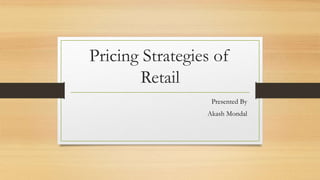Pricing Strategies of Retail.pptx
This document discusses pricing strategies used by retailers. It defines retail price as the manufacturing cost plus markup costs charged to customers. Retailers consider both internal factors like costs and objectives, as well as external factors like competition and demand when setting prices. Common pricing strategies include cost-oriented approaches that add a percentage markup to costs, demand-oriented approaches that consider customer willingness to pay, and competition-oriented approaches that match competitors' prices. Specific strategies mentioned are skimming prices that are initially high and lowered over time, market penetration prices that are low to drive sales volume, and bundling or multi-unit discounts to increase sales of related products.

Recommended
More Related Content
Similar to Pricing Strategies of Retail.pptx
Similar to Pricing Strategies of Retail.pptx (20)
More from Diksha Vashisht
More from Diksha Vashisht (20)
Recently uploaded
Recently uploaded (8)
Pricing Strategies of Retail.pptx
- 1. Pricing Strategies of Retail Presented By Akash Mondal
- 2. INTRODUCTION The price at which the product is sold to the end customer is called the retail price of the product. Retail price is the summation of the manufacturing cost and all the costs that retailers incur at the time of charging the customer , also known as the Mark Up Cost.
- 3. ELEMENTS OF RETAIL PRICE Cost of Goods : Cost of merchandise, Expenses incurred towards transportation , Taxes , duties levies , etc. Expenses Incurred : Fixed Expenses , Variable Expenses Fixed Expenses : Shop Rent , Head Office costs etc Variable Expenses : Merchandise margins , Product mix
- 4. Retail Price = Cost + Mark Up Cost of a Product = Rs. 300 Mark Up = Rs. 180 Retail Price = Rs. 480 (Cost of product + Mark up) Mark Up % on Retail = 180/480 = 37.5% Mark Up % on Cost = 180/300 = 60%
- 5. FACTORS INFLUENCING RETAIL PRICES Internal Factors • Manufacturing Cost • The Predetermined Objectives • Image of the firm • Product Status • Promotional Activity External Factors • Competition • Buying power of consumers • Government Policies • Market Conditions
- 6. PRICING STRATEGIES • Cost Oriented • Demand Oriented • Competition Oriented
- 7. COST ORIENTED • Cost plus Pricing – The company sets prices little above the manufacturing cost. For Example , if the cost of a product is Rs. 600 per unit and the marketer expects 10% profit , then the selling price is set to Rs. 660. • Break-Even Pricing – The retail company determines the level of sales needed to cover all the relevant fixed and variable costs. They break-even when there neither profit nor loss. • Target Return Pricing – The retail company sets prices in order to achieve a particular Return on Investment (ROI).
- 8. DEMAND ORIENTED • Focusses on quantities the customers would buy at various prices • It depends on perceived value attached to the product by customers • Sometimes a high priced product is perceived to be of high value • Sometimes a low priced product is perceived to be of high value
- 9. COMPETITION ORIENTED • Competitors play a key role in determining price • Retailers fix price on par with the competitors • Retailers fix price above the competitor’s price • Retailers fix price below the competitor’s price
- 10. APPROACHED TO PRICING STRATEGY • Skimming Price • Market Penetration • Leader Pricing • Price Bundling • Multi-Unit Pricing • Discount Pricing • Everyday Low Pricing • Odd Pricing
- 11. Skimming Price • It is a pricing strategy where in firms strategize to charge a high price initially and attract customers. • Gradually reduce if it is necessary Market Penetration • It is a pricing strategy in which the retailer seeks to achieve large revenues by setting low prices and selling high unit volume • Opposite of Market Skimming • Low prices stimulate purchases • Low prices discourages competitors from entering the market
- 12. Leader Pricing • Retailer sells few items at deep discounts • This increases traffic and sales • Heavily advertised to attract customers into the store Price Bundling • Retailer bundles a few products and offers them at a particular price • Price bundling helps increase sales of related items
- 13. Multi-Unit Pricing • Retailer offers discounts to customers who buy in large quantities or who buy a product in bundle • This involves value pricing for more than one of the same item • Example : Offer price of one T-Shirt for Rs. 250 and two T-Shirt for Rs. 350 Everyday Low Pricing • Strategy developed by retailers who continually price their products lower than the other retailers in the area. • Example : Food Bazaar
- 14. Odd Pricing • Strategy to set retail prices in such a manner that the price ends in odd numbers. • Example : Rs. 99, Rs. 199 etc
- 15. THANK YOU! Open To Questions
